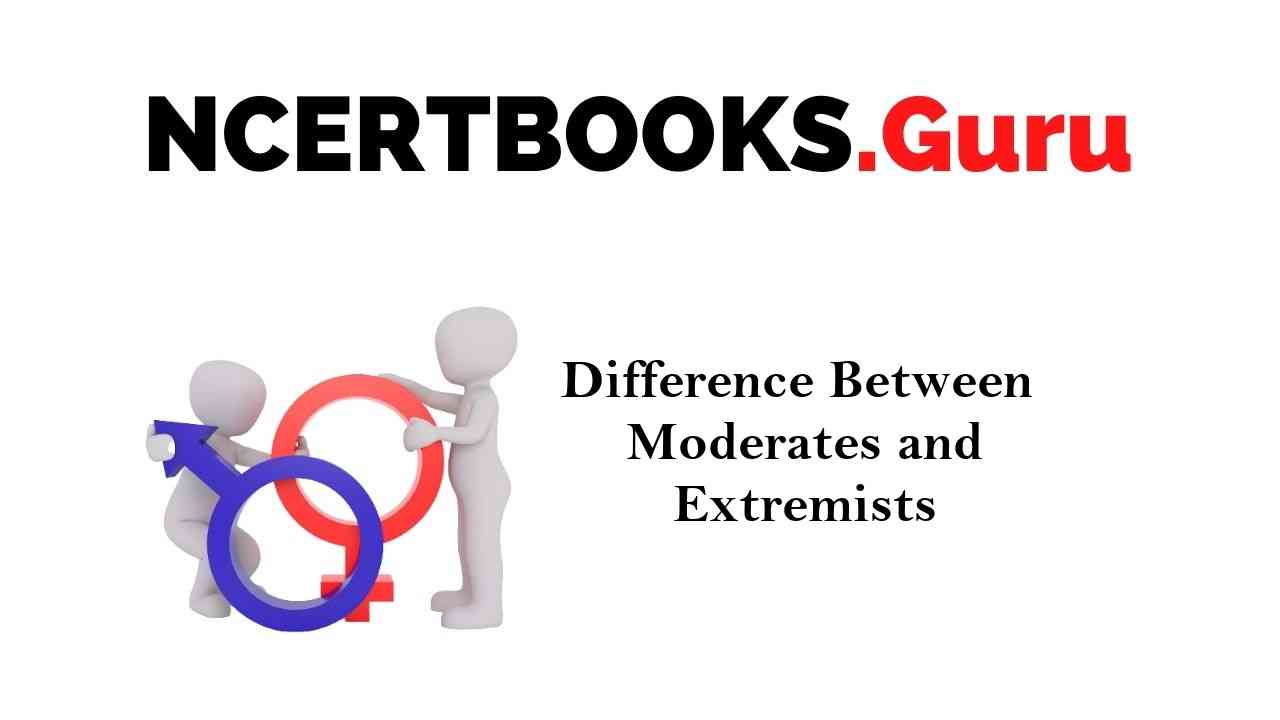The Early Nationalist, also known as the Moderates, were a party of Indian politicians active between 1885 and 1907. They were labelled “Early Nationalists” because they believe in demanding changes while using constitutional, nonviolent methods to reach their targets. Their advent marked the launch of India’s unified national revolution.
You can also find differences between articles on various topics that you need to know. Just tap on the quick link available and get to know the basic differences between them.
What is the Difference Between Moderates and Extremists
Pherozeshah Mehta and Dadabhai Naoroji were some of the powerful moderate figures. Extremists were the people who had the value or state of being serious or complaining of extreme steps or thoughts. Usually, Extremists are opposed to Moderates beliefs. For example, the difference between Extremist and Moderate Muslims is frequently illustrated in Western countries in contemporary speeches about Islam or Islamic political movements.
| Subject | Moderates | Extremists |
| The Ideological Framework | Moderates agree that nonviolent and constitutional instability is successful. | Extremists were progressive in their approach, and their requests have been attacking. They trusted themselves as a tool against conquest. |
| Contributions to the System | General Management Reform Movement and Human Rights Protection are some of the contributions of Moderates. | The contribution of Extremists include Swaraj’s appeal, adding value to the surge in social mobilization, the Extension of Nationalism, Raising the bottlenose, Revolutionary movement funding, Communalism Rising, Co-operative companies promoted, and Establishment of rural sanitation voluntary organizations. |
| Mass Base | Moderates were quite elitist. | Extremists were predominantly urban-medium. |
| Methods | Moderates had legislative demands. | Extremists were radical and believed in militant tactics including, though not limited to, key individuals’ execution. |
| The Goals and the Strategies | The Moderates had the aspirations of self-government. | The extremist proposed Swaraj or complete self-governance. |
| Members of Party | Dadabai Naoroji, A.O. Hume and Gopal Krishna Gokhale were some of the faction Moderates Leaders. | Aurobindo Ghosh, Bal Gangadhar Tilak, Lala Lajpat Rai and Bipin Chandra Pal were the Extremists leaders of our nation. |
The Ideological Framework
The First and Foremost difference between Moderates and Extremists is that Moderates agree that nonviolent and constitutional instability is successful. They had much faith and fair play in the British sense of justice. The theories of Western thinkers such as Mill, Burke, Spencer and Bentham influenced them.
Western ideas of capitalism, democracy, equity and equality were imbibed with moderation while on the other hand, Extremists were progressive in their approach, and their requests have been attacking. They trusted themselves as a tool against conquest. Indian culture, cultural heritage, national education and traditional Hindu symbols became the ideological inspiration. The Ganapati and Shivaji Festivals are therefore resurrected to awaken the people.
They wanted to instil patriotism and generate the spirit of nationalism in the majestic culture of India. They always prayed for strength for the mother country to the goddesses of Kali and Durga. Four values are directed to make the people themselves conscious of their national identity: Swarajya, Swadeshi, Boycotting international products, and National preparation.
Contributions to the System
General Management Reform Movement and Human Rights Protection are some of the contributions of Moderates. In contrast, the contribution of Extremists include Swaraj’s appeal, adding value to the surge in social mobilization, the Extension of Nationalism, Raising the bottlenose, Revolutionary movement funding, Communalism Rising, Co-operative companies promoted, Establishment of rural sanitation voluntary organizations, protective policing forces, supervision of trade fairs and pilgrims’ meetings to finance relief for famines and another disaster.
Mass Base
Moderates were quite elitist. They became part of an urban setting, and most people in England stayed. Most moderate politicians appreciate British political institutions. They did not oppose India’s British rule, but the “Un-British” nature of the British rule in India is what they opposed. On the other hand, Extremists were predominantly urban-medium. For ‘Indians,’ they believed in India. They decided to project India’s “cultural nationalism.”
Methods
Prayer. Rosary, appeal, convincing. Moderates had legislative demands, and hence their upheaval. They were considered ‘Passive Opposition’ for their tactics. They had a boycott style of work, whereas Extremists were radical and believed in militant tactics including, though not limited to, key individuals’ execution.
The Goals and the Strategies
The Moderates had the aspirations of self-government, and they claimed that political ties to Britain were at the root of Indian concern and that the time was not ready for the British rule to face a direct challenge. At the same time, The extremist proposed Swaraj or complete self-governance, and they claimed that they trust themselves as a tool against the law. They encouraged Swadeshi and international products boycott.
Members of Party
Dadabai Naoroji, A.O. Hume and Gopal Krishna Gokhale were some of the faction Moderates Leaders. At the same time, Aurobindo Ghosh, Bal Gangadhar Tilak, Lala Lajpat Rai and Bipin Chandra Pal were the Extremists leaders of our nation.
